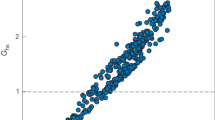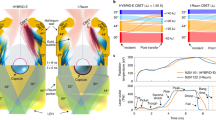Abstract
The application of Inertial Confinement Fusion to power production requires the development of a high-yield fusion capsule. Theoretical design calculations suggest that a single shell capsule with a uniformly distributed deuterium-tritium (DT) fuel layer on the inside surface could give the desired high-gain performance when directly driven with 0.35 µm laser light. This design requires operation at cryogenic temperatures necessary to condense DT (20–30 K) and a means of levitating the fuel layer inside the capsule. On e recently suggested method for making this capsule is to use a rigid foam matrix to support the condensed DT in a spherical shell configuration. For such a capsule to be successfully fielded, a number of critical materials problems must be solved.
Similar content being viewed by others
References
K.S. Bruechner and Siebe Jorna, “Laser-Driven Fusion,” Reviews of Modern Physics, 46, 2 (April 1974) p. 325.
T.H. Johnson, “Inertial Confinement Fusion: Review and Perspective,” Proceeding of the IEEE, 72 (May 1984) p. 548.
J. Nuckolls, L. Wood, A. Thiessen, and G. Zimmerman, “Laser Compression of Matter to Super-High Densities; Thermo Nuclear (CTR) Applications,” Nature, 239 (1972) p. 139.
J.J. Duderstadt and G.A. Moses, Inertial Confinement Fusion, John Wiley and Sons, New York, 1982.
J.H. Nuckolls, “The Feasibility of Inertial Confinement Fusion,” Physics Today, 35, 9 (1982) p. 24.
R.S. Craxton, R.L. McCrory, and J.M. Soures, “Progress in Laser Fusion,” Sci. Am., 255 (1986) p. 68.
F. Ze, L.J. Suter, S.M. Lane, E.M. Campbell, W.C. Mead, J.D. Lindl, M.D. Rosen, D.W. Phillion, C.W. Hatcher, R.P. Drake, J.S. Hildum, and K.R. Manes, “Compression Measurements in Ablatively Driven Inertial Confinement Fusion,” Plasma Phys. of Controlled Fusion, 10 (1986) p. 33.
A. Rosencwaig, J.L. Dressler, J.C. Koo, and C.D. Hendricks, “Laser Fusion Hollow Glass Microspheres by the Liquid Droplet Method,” Lawrence Livermore National Laboratory, Livermore, CA, Report UCRL-81421 (1978).
M. Nogami, J. Hayakawa, and T. Moriya, “Fabrication of Hollow Glass Microspheres in the Na2O-B2O3-SiO2 System from Metal Alkoxides,” J. Material Sci., 17 (1982) p. 2845.
J.H. Campbell, J.Z. Grens, and J.F. Poco, “Preparation and Properties of Hollow Glass Microspheres for Use in Laser Fusion Experiments,” Lawrence Livermore National Laboratory, Livermore, CA, Report UCRL-53516 (1983).
D.E. Solomon, editor, 1981 Inertial Fusion Research Annual Technical Report, KMS Fusion, Inc., Ann Arbor, MI, DOE/DP/40030-4, KMSF-U1198 (1981).
S.A. Letts, D.W. Myers, and L.A. Witt, “Ultrasmooth Plasma Polymerization Coatings for Laser Fusion Targets,” J. Vac. Sci. Technol., 19 (1981) p. 739.
J.H. Campbell J.Z. Grens, J.F. Poco, and B. Ives, “Preparation and Properties of Poly (Vinyl Alcohol) Microspheres,” Lawrence Livermore National Laboratory, Livermore, CA, Report UCRL-53750 (1986).
V.S. Bushvev, V.M. Dorogotoutsev, A.I. Isakov, N.S. Kobets, N.M. Kozyreva, V.V. Korshak, L.A. Krupinina, Yu. A. Merkul’ev, and A.I. Nikitenko, “Polymer Laser Targets,” Trudy Ordena Lenina Fizicheskogo Institute im. R. V. Lebedava 12, (1980), p. 72–83; translation UCRL-11924, Lawrence Livermore National Laboratory, Livermore, CA.
L.B. Kool, R.L. Nolen, and K.W. Sherwood; J. Vac. Sci Technol., 18 (1981) p. 1233.
K. Kim, B.J. Smoot, R.L. Woerner, and C.D. Hendricks, “A New Technique for Fabricating Cryogenic Laser Fusion Targets Using Cold-Gas Jets., Appl. Phys. Lett., 34 (1979) p. 282.
K. Kim and H. Rieger “Cryogenic Inertial Confinement Fusion Target Fabrication System Directly Operable Inside a Room Temperature Target Chamber,” Appl. Phys. Lett., 37 (1980) p. 425.
Laser Program Annual Report 1984, Lawrence Livermore National Laboratory, Livermore, CA, Report UCRL-50021-84 (1985), p. 4-12 to 4-15.
Laser Program Annual Report 1985, Lawrence Livermore National Laboratory, Livermore, CA, Report UCRL-50021-85 (1986), p. 3-23 to 3-27.
K. Kim, L. Mok, M.J. Erienborn, and T.P. Bernat, Vac Sci. Technol., A3(3), (1985) p. 1196.
L. Mok, K. Kim, T.P. Bernat and D.H. Darling, J. Vac. Sci. Technol., A1(2), (1983) p. 897.
T. Bernat, D.H. Darling, and J.J. Sanchez “Application of Holographic Interferometry to Cryogenic ICF Target Characterization,” J. Vac. Sci. Technol., 20 (1982) p. 1362.
D.H. Darling and R.A. Sacks, “Wetted Foam Capsules for Direct Drive ICF Reactor Application,” Lawrence Livermore National Laboratory, Livermore, CA, Report UCRL-93951 (1986).
R.A. Sacks and D.H. Darling “Direct Drive Cryogenic Capsules Employing DT Wetted Foam,” Lawrence Livermore National Laboratory, Livermore, CA, Report UCRL-94381 (1986).
Laser Program Annual Report 1985, Lawrence Livermore National Laboratory, Livermore, CA, Report UCRL-50021-85 (1986), p. 3-2 to 3-22.
R.M. Kulsrud, H.P. Furth, E.J. Valeo, and M. Goldhaber, “Fusion Reactor Plasmas with Polarized Nuclei,” Phys. Rev. Lett., 49 (1982) p. 1248.
P.C. Souers, E.M. Fearon, E.R. Mapoles, J.R. Gaines, and J.D. Sater “Nuclear Spin Polarization of Solid DT,” Lawrence Livermore Laboratory, Livermore, CA, Report UCRL-92700, Rev 1. (1985).
Laser Program Annual Report 1985, Lawrence Livermore National Laboratory, Livermore, CA, Report UCRL-50021-85 (1986), p. 3-27 to 3-31.
Author information
Authors and Affiliations
Additional information
J. H. Campbell received a BS in Chemistry at Rochester Institute of Technology and a PhD in Physical Chemistry at the University of Illinois.
Work performed under the auspices of the U. S. Department of Energy by Lawrence Livermore National Laboratory under contract number W-7405-ENG-48.
Rights and permissions
About this article
Cite this article
Campbell, J.H. Development of Direct Drive, High-Gain Capsules for Inertial Fusion: A Materials Challenge. MRS Bulletin 11, 26–29 (1986). https://doi.org/10.1557/S0883769400054464
Published:
Issue Date:
DOI: https://doi.org/10.1557/S0883769400054464




